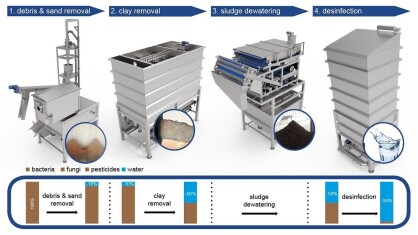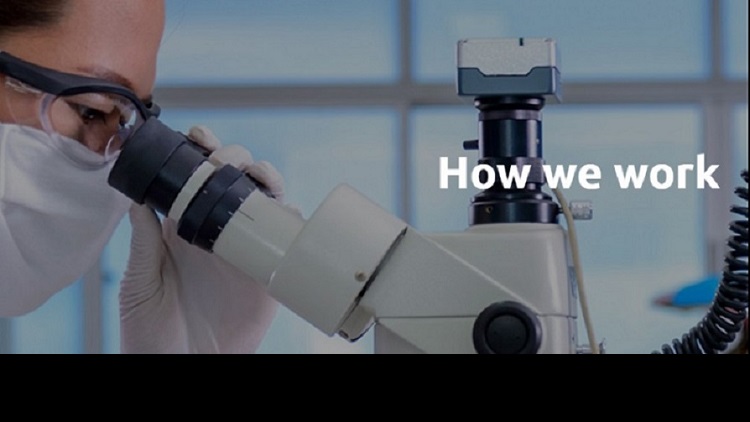Conditioning
Bulb grower Schutte and VAM realise lower bacterial load and zero discharge
After harvesting, viruses, fungi and pesticides need to be rinsed from flower bulbs. However, several restrictions apply to this. For example, it is forbidden to discharge used water or pesticide traces into the surface water. However, higher than permitted pesticide levels are mainly measured in areas with flower nurseries, bulb growers, greenhouse horticulture and open soil vegetable growing. According to the EU Water Framework Directive, these levels must be reduced to zero within four years. Stricter guidelines for discharges and the ?stacking? of pesticides are also being introduced. Regulatory authorities are working towards ?zero discharge?: a closed water cycle without waste water emissions. Arable flower bulb grower W. and J. Schutte, based in Nagele, the Netherlands, grow some 170 hectares of crops, including tulips, lilies and gladioli. The company started a unique project named ?Duurzame Waterkwaliteit? ? ?Sustainable Water Quality?. The ambitious goal: not a single drop from the surrounding fields was allowed to end up in the waterways and on the land where bulbs grow, to prevent the spread of unwanted substances. In addition to reducing fungi and viruses in the rinsing water, the goal was also to remove traces of crop protection products from the water Reuse of washing water plays an important role in W. and J. Schutte?s solution. Trenches surrounding the land lead water to a central point, from where it is transported to a rinsing basin. A fully automated system from VAM WaterTech purifies the process water. This system first removes bulb skins, root remains, and remaining fine sand and other floating particles from the water. The subsequent disinfection step removes germs, viruses, fungi and pesticide residues. This approach reduces disease pressure, which in turn allows less use of plant protection products and allows water to be used in more different ways, in the rinsing process and on site. Water intake is also minimised. Water can be reused in the rinsing process, by the field sprayer, or used to hose down machinery. ?Flower bulbs are dug up together with a relatively large amount of soil, which requires a lot of rinsing water,? says grower Jeroen Schutte. ?If we can ensure that water is free from fungi and viruses, fewer crop protection agents are needed. This helps us to keep the quality of the products high and to meet various environmental standards. Even if a new form of contamination emerges in the future, good hygiene practices will protect us from it.?
12 February, 2020
After harvesting, viruses, fungi and pesticides need to be rinsed from flower bulbs. However, several restrictions apply to this. For example, it is forbidden to discharge used water or pesticide traces into the surface water. However, higher than permitted pesticide levels are mainly measured in areas with flower nurseries, bulb growers, greenhouse horticulture and open soil vegetable growing. According to the EU Water Framework Directive, these levels must be reduced to zero within four years. Stricter guidelines for discharges and the stacking of pesticides are also being introduced. Regulatory authorities are working towards zero discharge: a closed water cycle without waste water emissions. Arable flower bulb grower W. and J. Schutte, based in Nagele, the Netherlands, grow some 170 hectares of crops, including tulips, lilies and gladioli. The company started a unique project named Duurzame Waterkwaliteit Sustainable Water Quality. The ambitious goal: not a single drop from the surrounding fields was allowed to end up in the waterways and on the land where bulbs grow, to prevent the spread of unwanted substances. In addition to reducing fungi and viruses in the rinsing water, the goal was also to remove traces of crop protection products from the water Reuse of washing water plays an important role in W. and J. Schuttes solution. Trenches surrounding the land lead water to a central point, from where it is transported to a rinsing basin. A fully automated system from VAM WATERTECH purifies the process water. This system first removes bulb skins, root remains, and remaining fine sand and other floating particles from the water. The subsequent disinfection step removes germs, viruses, fungi and pesticide residues. This approach reduces disease pressure, which in turn allows less use of plant protection products and allows water to be used in more different ways, in the rinsing process and on site. Water intake is also minimised. Water can be reused in the rinsing process, by the field sprayer, or used to hose down machinery. Flower bulbs are dug up together with a relatively large amount of soil, which requires a lot of rinsing water, says grower Jeroen Schutte. If we can ensure that water is free from fungi and viruses, fewer crop protection agents are needed. This helps us to keep the quality of the products high and to meet various environmental standards. Even if a new form of contamination emerges in the future, good hygiene practices will protect us from it.











